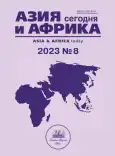Догоняющий и перегоняющий рост развивающихся стран: масштабы, факторы, проблемы и перспективы. Часть 2
- Авторы: Мельянцев В.А.1
-
Учреждения:
- МГУ им. М.В.Ломоносова
- Выпуск: № 8 (2023)
- Страницы: 5-11
- Раздел: Актуальная проблема
- URL: https://journals.rcsi.science/0321-5075/article/view/141078
- DOI: https://doi.org/10.31857/S032150750027153-0
- ID: 141078
Цитировать
Полный текст
Аннотация
Ключевые слова
Список литературы
- Мельянцев В.А. Догоняющий и перегоняющий рост развивающихся стран: масштабы, факторы, проблемы и перспективы. Часть 1. Азия и Африка сегодня. 2023. № 7. С. 5–13. doi: 10.31857/S032150750026562-0
- Мельянцев В.А. Глобализация, ее плоды и тени. Страны Востока и Россия в глобальных процессах. Отв. ред. И.В. Дерюгина. М., 2022. С. 53–67.
- Мельянцев В.А. Современный экономический рост развивающихся стран: важнейшие тенденции, пропорции, факторы и социальные последствия. Восток (Oriens). 2021. № 6. doi: 10.31857/S086919080017343-4
- World Inequality Lab. World Inequality Report, 2022. Paris, 2022.
- Мельянцев В.А. Насколько масштабно и быстро развивающиеся страны догоняют развитые? Восток (Oriens). 2023. № 3. doi: 10.31857/S086919080025205-2
- Gedminas T., Kevin D. 2023. The Path to 2075: Slower Global Growth, But Convergence Remains Intact. The VoxEU. 04.01.2023. https://cepr.org/voxeu/columns/path-2075-slower-global-growth-convergence-remains-intact (accessed 04.01.2023)
- The World Bank. Falling Long-Term Growth Prospects: Trends, Expectations, and Policies. Washington, D.C., 2023.
- WIPO. Global Innovation Index, 2022. Geneva, 2022.
Дополнительные файлы











